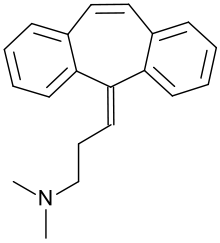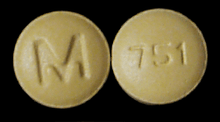Cyclobenzaprine
 | |
 | |
| Clinical data | |
|---|---|
| Trade names | Amrix, Flexeril |
| AHFS/Drugs.com | Monograph |
| MedlinePlus | a682514 |
| Pregnancy category |
|
| Routes of administration | By mouth |
| ATC code | |
| Legal status | |
| Legal status |
|
| Pharmacokinetic data | |
| Bioavailability | 33% to 55%[1][2] |
| Metabolism | major: CYP3A4, CYP1A2; minor: CYP2D6, N-demethylation[3] |
| Elimination half-life | 32 hours (range 8–37 hours; n=18)[4] |
| Excretion | renal |
| Identifiers | |
| |
| CAS Number | |
| PubChem CID | |
| IUPHAR/BPS | |
| DrugBank | |
| ChemSpider | |
| UNII | |
| KEGG | |
| ChEBI | |
| ChEMBL | |
| ECHA InfoCard |
100.005.588 |
| Chemical and physical data | |
| Formula | C20H21N |
| Molar mass | 275.387 g/mol |
| 3D model (JSmol) | |
| |
| |
| (verify) | |
Cyclobenzaprine, sold under the brand name Flexeril among others, is a muscle relaxer medication used to relieve skeletal muscle spasms and associated pain in acute musculoskeletal conditions.[5] It is the best-studied drug for this application.[6] It has also been used off-label for fibromyalgia treatment.[7]
As of 2015 the cost for a typical course of medication in the United States is less than US$25.[8]
Medical use
After sustaining an injury, painful muscle spasms may occur to stabilize the affected body part and prevent further damage. Cyclobenzaprine is used to treat such muscle spasms associated with acute, painful musculoskeletal conditions.[5] It decreases pain in the first two weeks,[6][9] peaking in the first few days, but has no proven benefit after two weeks.[6][10] Since no benefit is proven beyond that, therapy should not be continued long-term.[11] It is not useful for spasticity due to neurologic conditions such as cerebral palsy.[11][12]
Cyclobenzaprine has also shown effectiveness in the treatment of fibromyalgia symptoms, with a reported number needed to treat of 4.8 (meaning that 1 patient out of every 4.8 benefits from treatment) for pain reduction, but no change in fatigue or tender points.[13] It may also be used along with other treatments for tetanus.[14]
Side effects
Cyclobenzaprine results in increased rates of drowsiness (38%), dry mouth (24%), dizziness (10%), and total adverse events.[10] Drowsiness and dry mouth appear to intensify with increasing dose.[15] Dysphagia, a life threatening side-effect, may rarely occur.[16]
The sedative effects of cyclobenzaprine are likely due to its antagonistic effect on histamine, serotonin, and muscarinic receptors. Agitation is a common side effect observed especially in the elderly. In general, the National Committee for Quality Assurance recommends avoiding the use of cyclobenzaprine in the elderly because of the potential for more severe side effects.[17] Treatment protocols and support should follow the same as for any structurally related tricyclic, such as tricyclic antidepressants.[18]
Some experts believe that cyclobenzaprine should be avoided in elderly patients because it can cause confusion, delirium, and cognitive impairment.[19][20]
Overdose
The most common effects of overdose are drowsiness and tachycardia.[5] Rare but potentially critical complications are cardiac arrest, abnormal heart rhythms, severe low blood pressure, seizures, and neuroleptic malignant syndrome.[5] Life-threatening overdose is rare,[5] however, as the median lethal dose is about 338 milligrams/kilogram in mice and 425 mg/kg in rats.[5] The potential harm is increased when central nervous system depressants and antidepressants are also used; deliberate overdose often includes alcohol among other drugs.[5]
Interactions
Cyclobenzaprine has major contraindications with monoamine oxidase inhibitors (MAOIs). At least one study also found increased risk of serotonin syndrome when cyclobenzaprine was taken with the serotonergic drugs duloxetine or phenelzine.[21]
These substances may interact with cyclobenzaprine:
- Central nervous system depressants (e.g. alcohol, opioids, benzodiazepines, nonbenzodiazepines, phenothiazines, carbamates, barbiturates, major tranquilizers)
- Monoamine oxidase inhibitors taken within two weeks of cyclobenzaprine may result in serious, life-threatening side effects.[11]
Cyclobenzaprine may affect the medications used in surgical sedation and some surgeons request that patients temporarily discontinue its use prior to surgery. The prescribing physician should be consulted prior to discontinuing, and resuming, cyclobenzaprine.[22]
Comparison to other medications
Cyclobenzaprine has been found to be not inferior to tizanidine, orphenadrine, and carisoprodol in the treatment of acute lower back pain, although none have been proven to be effective for long-term use (beyond two weeks of treatment). No differences in pain or spasm scores were noted among these agents, nor when compared to benzodiazepines.[23] However, nonbenzodiazepine (including cyclobenzaprine) treatment was found to have a lower risk of medication abuse and continuation of use against medical advice. Side effects such as sedation and ataxia are also less pronounced with nonbenzodiazepine antispasmodics.
In a study on the treatment of musculoskeletal pain treatment with cyclobenzaprine alone or in combination with ibuprofen, no significant differences in pain scores were noted among the three treatment groups. Peak benefit was found to occur on day seven of the treatment for all groups.[24]
Formulations

By mouth, cyclobenzaprine is marketed as Apo-Cyclobenzaprin, Fexmid, Flexeril and Novo-Cycloprine. It is available in generic form. A once-a-day, extended-release formulation, Amrix, is available.[25] Cyclobenzaprine is also used by compounding pharmacies in topical creams.
Cyclobenzaprine is regulated in the U.S. for prescription use only. Though it does not fall within most governmental guidelines as a controlled substance, possession of it without a valid or current prescription may be illegal, depending upon various state and local laws.
Research
A rapidly absorbed form of cyclobenzaprine is being studied in the treatment for post-traumatic stress disorder.[26]
See also
References
- ↑ Micromedex® 2010 – DRUGDEX® Evaluations (Cyclobenzaprine Hydrochloride)
- ↑ "Cyclobenzaprine Hydrochloride Tablets USP Revised: April 2005 Rx only". nih.gov. Retrieved 1 October 2016.
- ↑ Teva Pharmaceuticals USA, Inc (May 2016). "AMR40470 (Amrix) Prescribing Information" (PDF).
- ↑ Teva Pharmaceuticals USA, Inc (May 2016). "AMR40470 (Amrix) Prescribing Information" (PDF).
- 1 2 3 4 5 6 7 "Flexeril (Cyclobenzaprine HCl) Tablets" (PDF). Food and Drug Administration. 2003. Retrieved 26 July 2009.
- 1 2 3 Chou R, Peterson K, Helfand M (2004). "Comparative efficacy and safety of skeletal muscle relaxants for spasticity and musculoskeletal conditions: a systematic review". Journal of Pain and Symptom Management. 28 (2): 140–175. doi:10.1016/j.jpainsymman.2004.05.002. PMID 15276195.
- ↑ "Cyclobenzaprine Hydrochloride". MicroMedex. 5 February 2010. Archived from the original (subscription required) on 4 February 2013. Retrieved 16 February 2010.
- ↑ Hamilton, Richart (2015). Tarascon Pocket Pharmacopoeia 2015 Deluxe Lab-Coat Edition. Jones & Bartlett Learning. p. 2. ISBN 978-1-284-05756-0.
- ↑ van Tulder, MW; Touray, T; Furlan, AD; Solway, S; Bouter, LM (2003). Van Tulder, Maurits W, ed. "Muscle relaxants for non-specific low back pain". Cochrane Database of Systematic Reviews. 2 (1–2): 91–9. doi:10.1002/14651858.CD004252. PMID 12804507.
- 1 2 Browning R; Jackson JL; O’Malley PG (2001). "Cyclobenzaprine and back pain: a meta-analysis". Archives of Internal Medicine. 161 (13): 1613–1620. doi:10.1001/archinte.161.13.1613. PMID 11434793.
- 1 2 3 "Cyclobenzaprine official FDA information, side effects, and uses". Drugs.com. October 2009. Retrieved 19 February 2010.
- ↑ Ashby, P; Burke, D; Rao, S (1972). "Assessment of cyclobenzaprine in the treatment of spasticity". J Neurol Neurosurg Psychiatry. 35 (5): 599–605. doi:10.1136/jnnp.35.5.599. PMC 494138. PMID 4563483.
- ↑ Tofferi JK, Jackson JL, O'Malley PG (15 February 2004). "Treatment of fibromyalgia with cyclobenzaprine: A meta-analysis". Arthritis Rheum. 51 (1): 9–13. doi:10.1002/art.20076. PMID 14872449.
- ↑ Smith, Blaine T.; Smith, Visiting Professor University of Oklahoma College of Pharmacy Blaine T. (2014). Pharmacology for Nurses. Jones & Bartlett Publishers. p. 122. ISBN 9781449689407.
- ↑ "Flexeril: Side effects". RxList.com. Archived from the original on 12 September 2008. Retrieved 22 February 2010.
- ↑ "MEDICATIONS AND DYSPHAGIA/ SWALLOWING RISKS" (PDF).
- ↑ "High risk medications" (PDF). National Committee for Quality Assurance. Archived from the original (PDF) on 1 February 2010. Retrieved 22 February 2010.
- ↑ Chabria, Shiven B (17 July 2006). "Rhabdomyolysis: a manifestation of cyclobenzaprine toxicity". Journal of Occupational Medicine and Toxicology. 1 (1): 16. doi:10.1186/1745-6673-1-16. PMC 1540431. PMID 16846511. Archived from the original on 21 October 2006.
- ↑ Canadian Agency for Drugs and Technologies in Health; 2015 Feb 23. Long-term Use of Cyclobenzaprine for Pain: A Review of the Clinical Effectiveness. PMID 25763449
- ↑ Potentially inappropriate medications for the elderly according to the revised Beers criteria. 2012. Duke Clinical Research Institute website. http://www.americangeriatrics.org/files/documents/beers/2012AGSBeersCriteriaCitations.pdf%5Bpermanent+dead+link%5D
- ↑ Keegan MT; Brown DR; Rabinstein AA (2006). "Serotonin syndrome from the interaction of cyclobenzaprine with other serotoninergic drugs". Anesthesia & Analgesia. 103 (6): 1466–8. doi:10.1213/01.ane.0000247699.81580.eb. PMID 17122225.
- ↑ Medical Practice of William H. Gorman, M.D. (Feb 18, 2014). "Medications to Avoid, Continue, or Stop - Before & After Surgery".
- ↑ "Medscape: Medscape Access". medscape.com. Retrieved 1 October 2016.
- ↑ Childers, M.K.; Petri, M.; Laudadio, C.; Harrison, D.; Silber, S.; Bowen, D. (2004). "Comparison of cyclobenzaprine alone versus cyclobenzaprine plus ibuprofen in patients with acute musculoskeletal spasm and pain". Annals of Emergency Medicine. 44 (4): S87. doi:10.1016/j.annemergmed.2004.07.286.
- ↑ "Patient Web site for AMRIX® (Cyclobenzaprine Hydrochloride Extended‐Release Capsules)". amrix.com. Retrieved 1 October 2016.
- ↑ "TNX-102 SL for Post-Traumatic Stress Disorder :: Tonix Pharmaceuticals Holding Corp. (TNXP)". www.tonixpharma.com. Retrieved 28 June 2016.